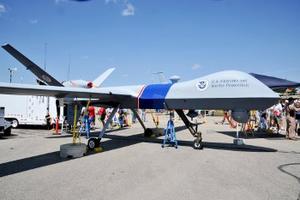Border securityDHS looking to UAVs to bolster border security
With the future of SBINet — the ambitious but trouble-plagued virtual fence project along the U.S.-Mexico border — unclear, DHS says it is now considering expanding its UAV fleet to beef up border security

Border Patrol UAV // Source: abacuspub.com
DHS is “seriously considering” expanding its arsenal of unmanned drones to patrol the nation’s borders and does not expect to have a comprehensive border security assessment completed until the end of the year, a senior DHS official told lawmakers last Thursday.
The department is continuing to reassess the problem-plagued SBInet border security network of computer-linked cameras, sensors, and other technology after it experienced repeated technical problems and schedule delays. “We have frankly failed in delivering what was promised in the beginning,” Mark Borkowski, the program’s executive director, told a joint hearing of two House Homeland Security panels on Thursday. “So the question for us is, what do we do now?”
Government Executive’s Chris Strohm writes that Borkowski said UAVs were not included in the SBInet plans when they were conceived but the department is now considering expanding its drone fleet to beef up border security.
A long-standing obstacle to deploying more aerial drones in U.S. civilian airspace, however, has been getting approval from the Federal Aviation Administration (FAA), which must ensure the unmanned aircraft do not collide with commercial aircraft and small private planes.
Last month, the FAA finally granted approval for U.S. Customs and Border Protection (CBP) to begin flying the Predator B drone from Arizona to west Texas along the southwest border with Mexico. Drone flights had previously been limited to Arizona and some parts of New Mexico.
Customs and Border Protection now operates five Predator B drones, one of which is flying along the northern border with Canada.
Borkowski did not offer a timeline for making a decision to buy more drones. Instead, he said the department is conducting an assessment of two border areas where SBInet technology is being used and expects it to be completed by the end of December.
DHS secretary Janet Napolitano earlier this year froze funding for any expansion of SBInet until the review is completed (“DHS freezes funds for U.S.-Mexico border security system,” 18 March 2010 HSNW).
Strohm quotes Randolph Hite, GAO’s director of information technology architecture and systems issues, to say that the government essentially does not know if it should be pursuing SBInet, even though more than $1 billion has been spent on the program to date.
The department has shrunk its goals and requirements for SBInet, but GAO does not have confidence that even those will be achieved, Hite said. “As a result, it remains unclear whether the department’s pursuit of SBInet is a cost effective course of action, and if it is, that it will produce expected results on time and within budget,” GAO concluded in a report released last Thursday (“GAO: Virtual border fence ‘unlikely to live up to expectations,’” 18 June 2010 HSNW).
The lack of a border security strategy also complicates efforts in Congress to pass an immigration overhaul. Democrats and Republicans alike contend the nation’s borders must be secured before comprehensive immigration legislation can advance.
Homeland Security Management Subcommittee chairman Rep. Christopher Carney (D-Pennsylvania)., told DHS officials during last Thursday’s hearing to give his panel its testing schedule for SBInet technologies that remain in the scaled-back program and an assessment of best- and worst-case timelines for achieving border security. Carney said he wants the information within a month.
